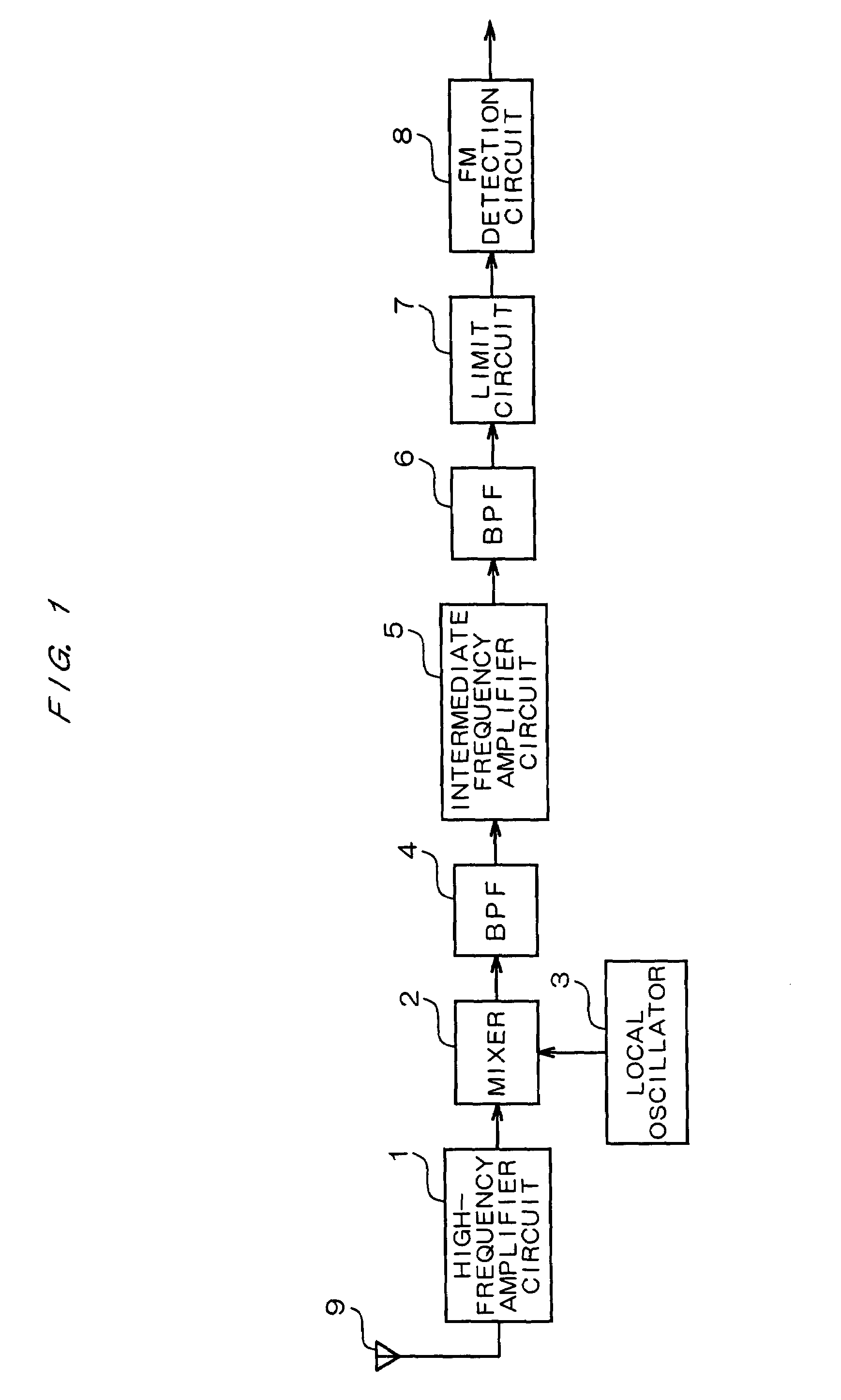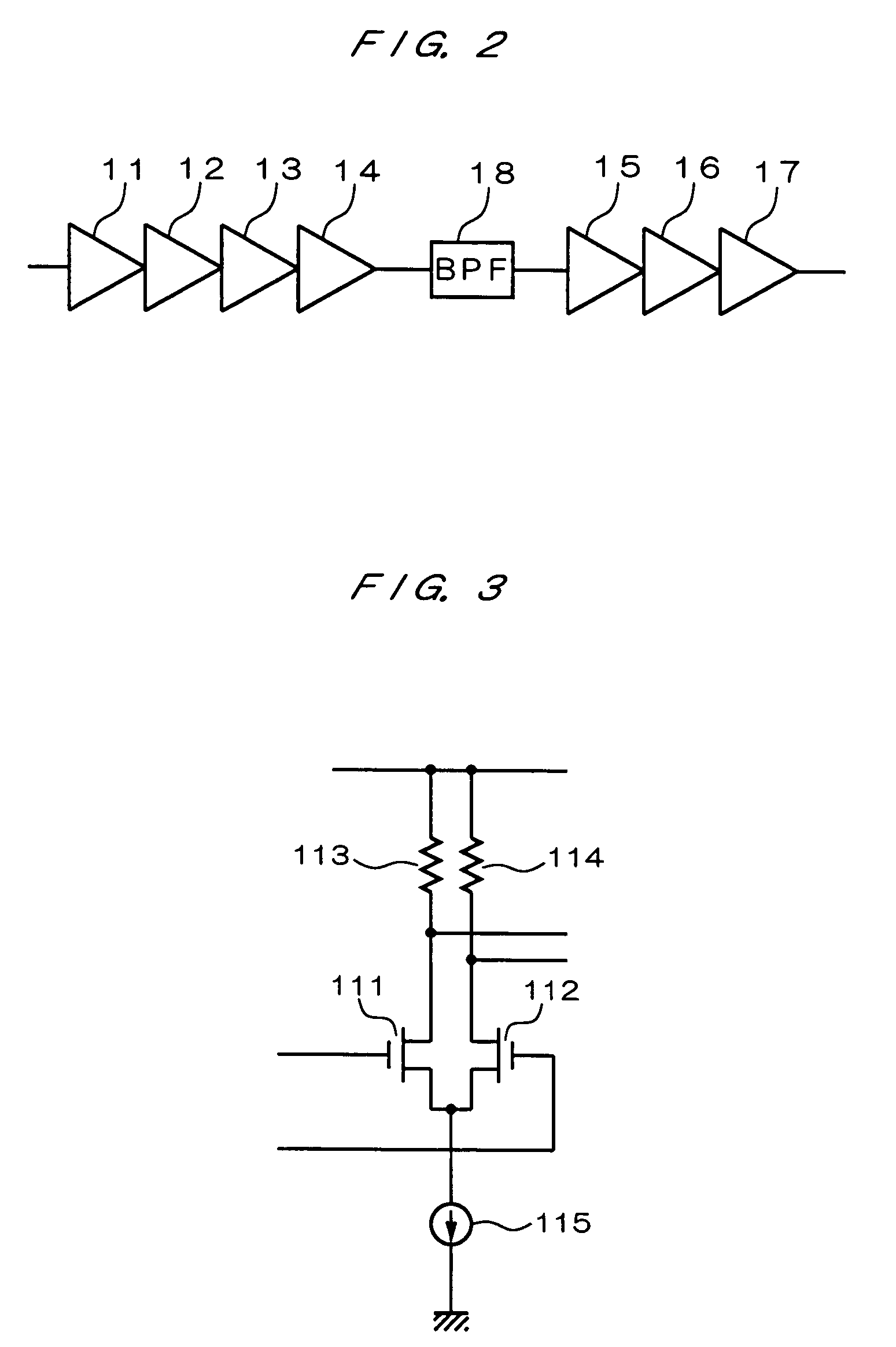Limit circuit
a circuit and limit technology, applied in the field of limit circuits, can solve the problems of amplifiers tending to be saturated and the noise components are more easily accumulated, and achieve the effects of reducing the 1/f noise generated in the fets, reducing and less to the reduction of the overall low-frequency nois
- Summary
- Abstract
- Description
- Claims
- Application Information
AI Technical Summary
Benefits of technology
Problems solved by technology
Method used
Image
Examples
first embodiment
[0040]FIG. 1 is a diagram showing a general configuration of an FM receiver including the limit circuit according to a first embodiment. As shown in FIG. 1, the FM receiver has a high-frequency amplifier circuit 1, a mixer 2, a local oscillator 3, BPF (Band Pas Filter) 4 and BPF 6, a intermediate frequency amplifier circuit 5, a limit circuit 7 and an FM detection circuit 8. An FM wave received by an antenna 9 is amplified by a high-frequency amplifier circuit 1 and then a local oscillation signal outputted from a local oscillator 3 is mixed so as to perform a frequency conversion from a high-frequency signal to an intermediate frequency signal. For instance, if a frequency of a signal outputted from the high-frequency amplifier circuit 1 is f1 and the frequency of the local oscillation signal outputted from the local oscillator 3 is f2, a signal having the frequency of f1−f2 is outputted from a mixer 2.
[0041]BPFs 4 and 6 are provided in foregoing and subsequent stages of an interme...
second embodiment
[0053]The above-mentioned first embodiment eliminates the noise components simply by inserting one BPF almost in the middle of the amplifiers in a plurality of stages. It is possible, however, to eliminate the noise components on the amplifier in each stage.
[0054]FIG. 4 is a circuit diagram showing the configuration of the limit circuit according to a second embodiment. The limit circuit according to this embodiment shown in FIG. 4 is constituted by cascading the amplifiers in seven stages 11A, 12A, . . . 17A. As the configurations of these amplifiers are basically the same, the detailed configuration and operation will be described hereafter by paying attention to the first-stage amplifier 11A.
[0055]The amplifier 11A is comprised of two transistors 111, 112, eight resistances 113, 114, 120, 121, 123, 124, 125 and 126, a constant current circuit 115 and five capacitors 116 to 119 and 122. Of these, the transistors 111, 112, resistances 113, 114 and constant current circuit 115 are i...
third embodiment
[0069]FIG. 6 is a circuit diagram showing the configuration of the limit circuit according to a third embodiment. The limit circuit according to this embodiment shown in FIG. 6 includes the amplifiers cascaded in seven stages 11C, 12C, . . . 17C and an additional circuit for taking out the signal outputted from the final-stage amplifier 17C and feeding it back to the first-stage amplifier 11C.
[0070]As the configuration of each of the amplifiers 11C to 17C is the same, a description will be given hereafter by paying attention to the first-stage amplifier 11C.
[0071]The amplifier 11C is comprised of the transistors 111a, 112a, resistances 113, 114 and constant current circuit 115. The amplifier 11C has the configuration which is basically the same as the amplifier 11A shown in FIG. 3. However, the transistors 111a, 112a shown in FIG. 5 are used instead of the transistors 111, 112. To be more specific, the transistors 111a, 112a have the gate length L and gate width W set large so that ...
PUM
 Login to View More
Login to View More Abstract
Description
Claims
Application Information
 Login to View More
Login to View More - R&D
- Intellectual Property
- Life Sciences
- Materials
- Tech Scout
- Unparalleled Data Quality
- Higher Quality Content
- 60% Fewer Hallucinations
Browse by: Latest US Patents, China's latest patents, Technical Efficacy Thesaurus, Application Domain, Technology Topic, Popular Technical Reports.
© 2025 PatSnap. All rights reserved.Legal|Privacy policy|Modern Slavery Act Transparency Statement|Sitemap|About US| Contact US: help@patsnap.com



